Learn to use real railroad
Lantern, Hand and Color Signals
Railroads use lights and hand signs so that train men and workers can "talk." The signs were first used over 130 years ago, before people had radios. Railroads needed men to be able to send signals from far or near. Many times, the signal man would be too far away to use a whistle or horn. Colors, lights and hand signals were all used.
Color Signals
On the railroad, different colors have meaning. Flags are colored to send a message. Flag color signals are:
Red - Stop
White - Go
Green - Go slowly - caution!
Blue - blue flags are placed on a car or other object on which men are working.
Lantern and Hand signals
The lantern and hand "talk" allows railroad men to signal each other, even when far away or when noise is too loud for whistles or shouting. Our pictures show a lantern, but men could also use flags or their arms. Lanterns allowed train crews to see signals at night.
 STOP! Swing lantern across tracks. STOP! Swing lantern across tracks. |  SLOW DOWN! Hold at arms length when train is moving. SLOW DOWN! Hold at arms length when train is moving. |
 GO! Raise straight up and down. GO! Raise straight up and down. |  GO BACK! Swing up and down in a circle at half an arm's length across track, when the train is moving. GO BACK! Swing up and down in a circle at half an arm's length across track, when the train is moving. |
 TRAIN HAS PARTED! This tells the trainmen that cars have come loose. Swing up and down in a circle at fill arm's length when the train is running. TRAIN HAS PARTED! This tells the trainmen that cars have come loose. Swing up and down in a circle at fill arm's length when the train is running. |  DO NOT GO! APPLY BRAKES! Swing straight above your head when train is standing. DO NOT GO! APPLY BRAKES! Swing straight above your head when train is standing. |
 GO! RELEASE BRAKES! Hold at arms length above your head when train is standing. GO! RELEASE BRAKES! Hold at arms length above your head when train is standing. |
To communicate with a lantern, the railroad worker would swing the lantern in various ways according to what message he wanted to send. Some messages could be quite quick and complex, meaning the workers really had to know their signals. They had to give them and read them. They could signal how many cars needed to moved and to where. From what I've read, if you missed or misread a given signal, you were in for an ear full of discipline from the more senior members of the crew.
Below is a set of very common set of hand lantern signals used by railroad workers.
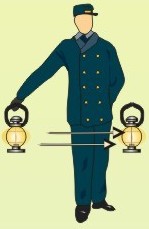 STOP | Stop signal. Lantern swung back and forth across tracks.NOTE: Any object waved violently by anyone on or near the track is a signal to stop |  |
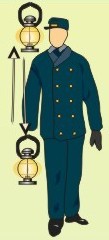 PROCEED | Proceed or go signal. Lantern raised up and down, vertically. |  |
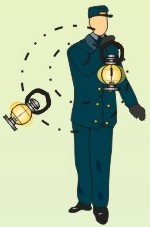 BACK | Back signal. Lantern swung vertically in a circle at half-arm's length across the track. |  |
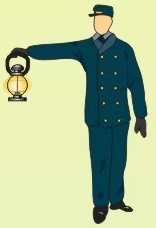 REDUCE SPEED | Reduce speed, or slow down signal. Lantern is held out to the side, at arm's length. |  |
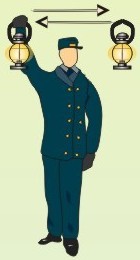 APPLY BRAKES | Apply brakes signal. Lantern is swung horizontally above the head. |  |
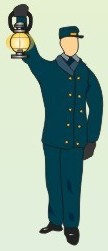 RELEASE BRAKES | Release brakes signal. Lantern is held at arm's length above the head. |  |
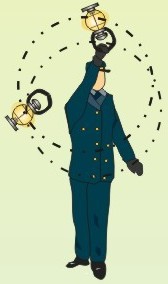 TRAIN HAS PARTED | Train has parted or come loose signal. Lantern is swung vertically in a circle at arm's length across the tracks.NOTE: While modern trains have made this signal obsolete, it was a very serious signal in its time. It meant part of the train was missing or disconnected and could be coasting into the rail yard and cause a collision/wreck. |  |




No comments:
Post a Comment
Feel free to make comments